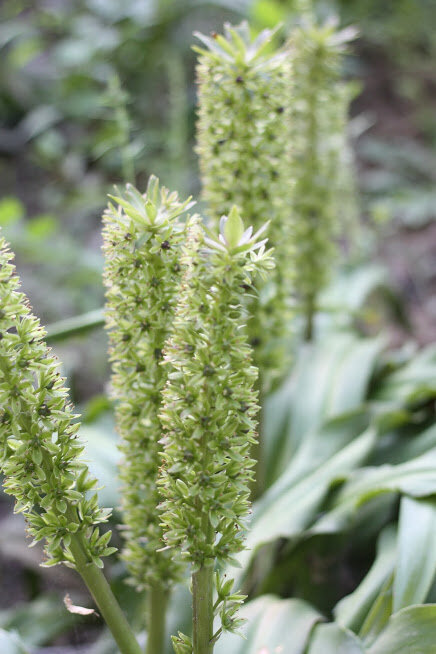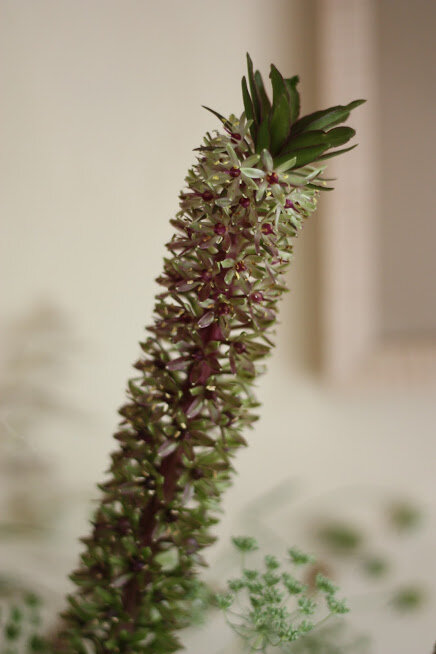Growing Pineapple Lilies (Eucomis) in the Garden and for Floral Design
Pineapple lilies sound like some sort of bizarre made-up flower until you see them in person.
But once you see them, you’ll never forget them. Big, strappy, tropical foliage in a large rosette with large flower stalks erupting from the center that beg for you to look at them. They look unreal - as if they were some sort of alien species that had invaded earth.
Best of all? They are actually pretty hardy plants. With good drainage and either mild winters or excellent insulation (through either mulch or snow cover) they will come back year after year, bigger and better and with more stems and flowers.
Pineapple Lilies last forever in the vase
Can you guess how long pineapple lilies can last in the vase? I’ll give you a hint - it’s usually in the double-digits as far as days go.
We had a pineapple lily cut from the field that I kid you not, lasted from July through September It was part of an ever changing display on our countertop, where we would cut a few stems of this and that to enjoy indoors.
Well, that pineapple lily was still looking good in September. It was starting to get a bit brown around the edges and we needed to make room for other items but it was still kicking it.
So from July to September, that’s 120 days.
Incredible, right?
You might think I’m lying about this, but I’m not. Both the flowers and foliage of eucomis last for a very long time. At least thirty days, but sometimes more than that (much more than that in this case).
If you are using them in weekly installations in hotels and restaurants, then they will more than pay themselves off by lasting you at least an entire month. How’s that for your bottom line? You also don’t have to worry about them going floppy or browning in the vase either.
Harvesting Pineapple Lilies
Pineapple lilies are best harvested when the first of the florets on the stem start to open. This is going to prolong the vase life of the flower, and will help to ensure you get the longest vase life possible.
Of course if you’re using it in event work (such as wedding design) then you may want to pick them when the florets are more open in order to have them looking more presentable and showy.
Harvest your eucomis during the cool of evening or early morning into clean deep buckets of water and a sharp pair of snips. Some people like to reach and snap off the flowering stalks - but I’m not quite that brave.
Luckily, eucomis have such a long vase life that you don’t have to worry about shuttling them into the home. We never bothered putting ours into the cooler because we were selling to florists - just be careful if you are storing them in a cooler for extended periods of time at low temperatures because they can develop mold and rot issues if left in the cooler for too long (we experienced this when purchasing pineapple lilies from the wholesaler ourselves.
Designing with Pineapple Lilies
Pineapple lilies are great for floral design for a couple of reasons. First of all, the fact that you don’t have to worry about them wilting or shedding petals makes them a very easy material to work with.
Secondly, the fact that they have a nice and fat stem allows you to work without fear of snapping the stem like you would with more delicate-stemmed flowers like poppies and ranunculus.
There’s also the fact that they have a very unique shape with their vertical upwards spire, as well as the fact that they have an excellent texture that contrast so well with the large fluffy petaled zinnias and dahlias and other flowers they are usually combined with.
I really think they add an exotic, luxurious touch to any arrangement they are part of. The fact that it is not easily recognizable really lends a bit of the mystery and intrigue of the arrangement - people are drawn to it and always ask what it is - and it is such a bold textural element that it will always make a statement just by being present.
Growing Pineapple Lilies
Pineapple lilies grow from corms. They look similar to canna bulbs or elephant ears (Colocasias) in that they are large, bulky, round root structures.
To plant pineapple lily corms, dig a shallow hole (or trench if you’re wanting to grow them for flower farm production) so that the top of the corm rests an inch or two underneath the soil. Water them in and wait until the weather starts to get warmer - you’ll see the tops of the large blade-like leaves poking out of the soil.
The leaves will keep poking out until you have a nice rosette of leaves - and it’s from the center of this rosette of leaves that the flower stem will start to form towards the end of summer. So long as you keep them well watered and fertilized, they’ll produce a nice and big flower stem (usually only one the first year).
Pineapple lilies technically are hardy in zones 7-10 so long as they’re kept in well draining soil and a somewhat sheltered environment. We haven’t had much issue with pineapple lilies overwinter since our winter is dry and mild, so if you have a colder, wetter winter you may have to lift your corms.
To lift your pineapple lily corms, wait until the first early frost (which will kill off the foiage). Gently elevate them out using a fork to push them out of the ground. Don’t worry about the foliage - it will still be fine so long as you keep the corms intact.
If you happen to break apart a corm, you can still save it - just ensure it has a growing tip or a sprout on the piece and replant it next year.
Store pineapple lily corms in peat or wood shavings (similar to storing a dahlia tuber) ensuring that it stays relatively cool and just moist enough to prevent it from drying out. Don’t let them freeze - a root cellar or a garage heated just enough to keep it from freezing would be perfect.
And if you’re a flower farming looking to branch into growing perennials for cut flower production, you won’t want to miss out on our book about growing perennials for cut flowers
Varieties of Pineapple Lilies to Grow for Cut Flowers
Not all pineapple lilies are equal when it comes to using as a cut flower - we like the large and impressive ones that put out a good 24-36” flower stalks.
The ‘Tugela’ series has a lot of great variety. Our favorite is ‘Tugela Jade’ - Green flowers with a lime green crest that open up into pure white, working well for wedding work since it goes so well with the white and silver color schemes that are so popular.
‘Tugela Ruby’ is a wonderful bicolor pineapple lily that fades from a dusky rose-pink to a dark burgundy green when in bud, and then opens up into creamy white flowers dusted with a cranberry red around the edges.
‘Sparkling Burgundy’ has dark burgundy, almost purple colored foliage along with dark purple flower stems and deep dark purple flower buds that then open up into light lavender flowers all along the stem.
If you’re a flower farmer and you’re looking for a great crop to sell to florists, these varieties of pineapple lily will be snatched up by your florists. You can read more on how to grow cut flowers like pineapple lilies for florists here.
You can’t go wrong with pineapple lilies
Versatile, hardy (at least in our zone 7) easy to grow, drought tolerant, spectacular in the vase with the longest vase life of pretty much any cut flower out there, there’s nothing that I don’t love about pineapple lilies.
Corms are spendier than other plants, but I believe that they’re well worth the cost, especially given the fact that they are perennial here, and have come back year after year after year to produce amazing flowers in the summer. I can’t imagine not growing them. Give them a try - you’ll get hooked!





